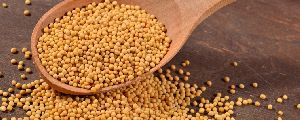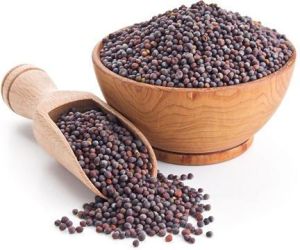
Yellow Mustard Seeds
Mustard seeds have been highly prized culinary oil-seeds being in use since earlier times. The seeds are fruit pods obtained from the mustard plant, in the Brassica family. Some of the close members of mustards in this family include cabbage, broccoli, brussels-sprouts, etc. Scientific name: Brassica juncea. Mustards are native to Asia Minor, but these days cultivated as one of the main commercial crop in Canada, India, China, and temperate climates of the European region.Mustards are winter crops. The plant reaches about 4-5 feet in height and bears golden yellow colored flowers. They are tiny, round seeds measuring about one mm in diameter found encased inside a fruit pod. In general, three main varieties of mustard are grown worldwide for use. White mustard seeds (Sinapis alba or Brassica alba): The seeds are light straw-yellow colored and are slightly larger than the other two varieties. White seeds exhibit mild pungency. Black mustards (Brassica nigra): The seeds commonly grow in South Asia. They are sharp and more pungent than the other two varieties.
...more
Turmeric
Turmeric (Curcuma longa), the main spice in the Indian dish curry, is arguably the most powerful herb on the planet at fighting and potentially reversing disease. Turmeric benefits include so many healing properties that currently there are over 10,000 peer-reviewed articles published proving turmeric benefits, especially one of its renowned healing compounds, curcumin. This puts turmeric on top of the list as one of the most frequently mentioned medicinal herbs in all of science. The next most popular studied herbs include garlic, cinnamon, ginseng, ginger and milk thistle. Turmeric comes from the Curcuma longa plant, which grows in India and other Southeast Asian countries. The dried root of the Curcuma longa plant is ground into the distinctive yellow turmeric powder. There are several chemical compounds found in turmeric, known as curcuminoids. The active substance in turmeric is curcumin.
Cultivation Type : Organic
...more
Natural Sesame Seeds
Sesame seeds are derived from a plant of the Sesamum genus and bear the scientific name of Sesamum indicum. These seeds are considered the oldest oilseed crop in the world and have been cultivated for more than 3,500 years. Evidence of their native forms in Africa and India. The sesame plant is extremely resilient and grows in places where many other crops fail, which is why it is heavily relied on for ages. Although it is a seed plant, it can still bother people with allergies and has a distinctly nutty flavor. Many of the health benefits are derived from the oils, which are found in higher concentration in sesame seeds than in any other oilseed crop in the world. The sesame plant is not more than 3 feet tall and the seeds are released from small pods along the plants’ axes. The seeds themselves are very small, only 3-4 mm long and 2 mm wide, yet 3.85 million metric tons are produced every year. They come in a wide variety of colors, depending on the variety or strain of the sesame plant. These seeds can be purchased either shelled or unshelled. They are commonly added to salads as an ingredient or topping for bread and grain products, crackers, sushi, cakes, soups, breading for fish and meat, and a wide variety of other applications.
Color : Black, White
Form : Seeds
...more
Hulled Sesame Seeds
sesame seeds are admired all around the world for their slightly sweet, nutty flavor and aroma that is enhanced by toasting. In the middle east, sesame seeds are ground into a paste called tahini and used in the savory dish, hummus and in sweet treats like halvah. In asian cuisine, they are used in sushi rolls, stir-fries and salads, to name a few. And throughout europe and america, sesame seeds are added to breads and other baked goods for a rustic, artisan touch and flavor. Sesame seeds are also highly valued for their high content of oil which contains essential fatty acids and is revered in some cultures for its healing properties. “open sesame”‚äîthe famous phrase from the arabian nights‚äîreflects the distinguishing feature of the sesame seed pod, which bursts open when it reaches maturity. Sesame seeds, an alkaline food, offer many nutritional benefits. They’re an excellent source of zinc, manganese, magnesium, copper, calcium, iron, phosphorus, vitamin b1 and dietary fiber. Sesame seeds also contain lignans, called sesamin and sesamolin, which can help lower cholesterol and blood pressure. White (hulled) sesame seeds are used the same as our natural brown sesame seeds. The outside coating has been removed to give them a uniform, creamy look. They’re a little “dressier” looking than the brown. Sesame seeds can be added to vegetable dishes, salads, breads, rolls, buns and muffins–or use the entire package to make tahini (see recipe on back of package). With a fresh batch of tahini on hand, homemade hummus can be just minutes away! or try using tahini in the cookie recipe on the back of the package for a scrumptious treat.
Cultivation Type : Organic
Form : Seeds
...more
Fenugreek Seed
Fenugreek is an annual herb with light green leaves and small white flowers. It’s of the pea family (Fabaceae) and also known as Greek hay (Trigonella foenum-graecum). The fenugreek plant stands erect at two to three feet tall, and the seed pods contain 10–20 small, flat, yellow-brown, pungent and aromatic seeds. Fenugreek seeds have a somewhat bitter taste, similar to celery, maple syrup or burnt sugar, and are often used to make medicine. However, fenugreek has a far more pleasant taste when cooked. The seeds are the most widely used part of fenugreek, which are usually dried and ground. The leaves are often used in cooking as well. Fenugreek can be taken by mouth or used to form a paste that’s applied to the skin to help heal inflammation. In manufacturing, fenugreek extracts are can be found in soaps and cosmetics. As noted in the book “Essential Oils in Food Preservation, Flavor and Safety,” fenugreek extract and oil are known to possess antimicrobial, antioxidant, antidiabetic and antitumorigenic activities. Cultivated in North Africa, the Middle East, Egypt and India, it has a long history as an ingredient in traditional medicine. The T. foenum-graecum galactomannan acts as a gum and an emulsifier, making it useful as a stabilizer as well as thickening agent for food. It’s also used as a spice and flavoring agent in food preparation.
Purity : 98%
Form : Seeds
Feature : Gluten Free, Non Harmul
...more
Fennel Seeds
fennel seed is the fruit of foeniculum vulgare – or what we commonly known as fennel – a flowering plant in the carrot family. Native to the mediterranean, these aromatic seeds are used in several cuisines around the world. Fennel seed has an oval shape and once dried takes on a greenish-brown color, which gradually fades to gray as the seeds age. Due to their similar sweet as well as subtle licorice-like taste, fennel seed is often confused with anise. usfda (defect action level ) : I average of 9.5% or more ash and / or more acid insoluble ash. fennel is an aromatic herb belonging to the parsley family. It is used as a spice and also possesses a sweet taste which is similar to anise. It is said that roman soldiers used to chew fennel seeds for strength. It is used both as a spice for beverages and veggie preparations and as a post-meal digestive aid and refreshment.
Form : Seed
Feature : Non Harmful
...more
Dill Seeds
The Vikings cultivated a plant they called “dilla,” or “soothing,” that was administered to babies. If you want to grow dill in your garden, plan for success. The mature plant produces thousands of seeds, most dill seeds germinate, and the plant can invade other growing beds. Dill likes a moist, well-drained soil in full sun, although it grows on most kinds of soils. Stress on the plant by heat or drought improves its flavor. If you let dill come up on its own, it will mature and go to seed before you have cucumbers. If you want to use dill in pickling, plant dill and cucumbers at the same time.
...more
Cumin Seeds
cumin, scientifically known as cuminum cyminum, belongs to the family apiaceae. It is extensively used as a condiment or a spice in culinary practices of the indian subcontinent and some other asian, african and latin american countries. Cumin boasts a number of important nutrients that can help keep you healthy. Because of its strong aroma, only a small amount of cumin essential oil is used in recipes to provide them with a powerful punch. Cumin essential oil is also considered healthy due to its bactericidal, carminative, digestive, diuretic, and antiseptic properties that provide numerous benefits. usfda (defect action level ) : I average of 9.5% or more ash and / or more acid insoluble ash. cumin is a good source of energy, vitamin a, c, e and b6, thiamine, riboflavin, niacin and minerals like iron, manganese, copper, calcium, magnesium, phosphorus, and potassium. It is also rich in protein and amino acids, carbohydrates, dietary fiber, and a reasonable amount of fats and fatty acids. Consuming about one teaspoon of cumin daily can help you meet your daily nutrient requirements.
Application : Cooking
Feature : Improves Digestion, Non Harmful
Form : Seeds
...more
Coriander Seeds
coriander, popularly known as dhania in india, is extensively used across various regional cuisines to flavour curries, stir fries, snacks, breakfast items – you name it! it is popular in mexico and the south western part of usa too, where it is utilised in salsas and mixed greens to burritos and meat dishes. While the fresh leaves are commonly topped on most dishes, the seeds and a ground powder (masala) are also used in cooking. The leaves are often used raw and added to the dish just before serving as heat tends to lessen its flavour rapidly. coriander is a flowering plant that belongs to the parsley family (leaves of coriander and parsley have comparative shape and size). It is said to have originated from south europe, north africa and west asia. Coriander was also one of the numerous plants cultivated in the hanging gardens of babylon. It was well known and regularly consumed in ancient egypt and greece, and is still among the most popular flavour boosters used in preparing various dishes across the globe. coriander seeds are plump and brown in colour, have a hollow cavity which bears essential oils that lend to the flavour of the dishes when used in cooking. They are harvested when the plant turns brown and its leaves start to dry and fall
Cultivation Type : Organic
Purity : 98%
Form : Seeds
...more
Chilly
Chili peppers, despite their fiery hotness, are one of the very popular spices known for their medicinal and health benefiting properties. The chili is a fruit pod of the plant belonging to the nightshade family (Solanaceae), of the genus, Capsicum. Chili plant is a small, perennial shrub with a woody stem, growing up to a meter in height. It is native to the Central American region where it employed as one the main spice ingredients in Mexican cuisine for centuries. Later, it was introduced to the rest of the world by Spanish and Portuguese explorers during the 16th and 17th centuries. Today chili pepper is grown widely in many parts of the world as an important commercial crop.
Cultivation Type : Organic
Application : Cooking, Fast Food, Sauce
Taste : Spicy
...more
Black Sesame Seeds
What is black sesame black sesame seeds (also called kala til) have a lot of beneficial properties, which can provide you with the required nutrition and also fight diseases at the same time. It is unbelievable how a tablespoon of these little seeds can help you rejuvenate your life and make you a healthier human being as you grow. Different cultures have used these sesame seeds in different ways for adding them in the food or using it as a home remedy. Due to their nutty flavor, they are very popular all around the world. The most popular ones are the ivory colored sesame seeds. You can have them cooked, or raw, or even roast them and eat them with some added flavors. sesame seeds very easily available in the market. They have a lot of variety. There is no particular one type of sesame seeds. There are assorted varieties with different nutrition values and health benefits added to them.
Cultivation Type : Organic
Color : Black
Purity : 100%
Form : Seeds
...more
Black Mustared Seeds
What Is Mustared Seeds Mustard seeds have been highly prized culinary oil-seeds being in use since earlier times. The seeds are fruit pods obtained from the mustard plant, in the Brassica family. Some of the close members of mustards in this family include cabbage, broccoli, brussels-sprouts, etc. Scientific name: Brassica juncea. Mustards are native to Asia Minor, but these days cultivated as one of the main commercial crop in Canada, India, China, and temperate climates of the European region.Mustards are winter crops. The plant reaches about 4-5 feet in height and bears golden yellow colored flowers. They are tiny, round seeds measuring about one mm in diameter found encased inside a fruit pod. In general, three main varieties of mustard are grown worldwide for use. White mustard seeds (Sinapis alba or Brassica alba): The seeds are light straw-yellow colored and are slightly larger than the other two varieties. White seeds exhibit mild pungency. Black mustards (Brassica nigra): The seeds commonly grow in South Asia. They are sharp and more pungent than the other two varieties.
Color : Black
Part : Seed
...more
Ajwain Seeds
What is ajwain it is one of the important herbs for indian kitchen to make the indian cuisine tasty. All the parts of this herb have very strong smell; hence it is called ugragandha in sanskrit. Ajwain has many health and medicinal values. It is well known seed for instant remedy for stomachache. The seed, oil, flowers and extract are used as medicine for various diseases. It is also one of the potent medicines to kill worms. It is extremely beneficial for earache, tooth ache, influenza, heart problems, arthritis, nasal blockage. The person feeling excessive sexual desire, may take it cool down himself. a spice that every indian household is all too familiar with and without which every dal tadka is incomplete, ajwain is derived from a herb plant that originated in our very own country. Ajwain seeds vary from being slightly olive green to brown in colour. All parts of this herb have a very strong scent hence it is also known as ugragandha in sanskrit. The seeds have a bitter and pungent flavour, somewhat like oregano, and because of its strong aromatic essence, it is often added to curries and pickles. It is one of those rare spices that fulfill the twin purpose of adding flavour and being good for health.
Moisture : 10% Max
...more
Caraway Seeds

Fennel

Turmeric Powder

Cumin Powder

Chilli Powder

Mustard Seeds

Ginger

chilli whole

seseme seeds

mustard black seed

Goods Insurance

Packing Crating Service

Valuation Services

Transport Insurance

Asset Reliability Service
Be first to Rate
Rate This